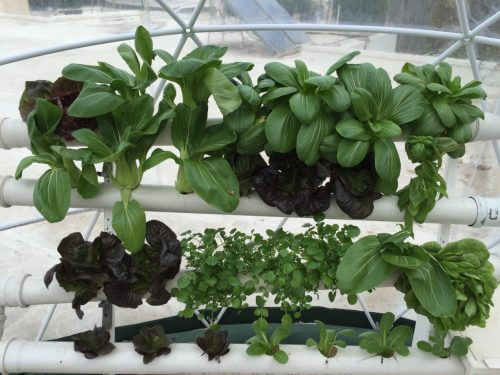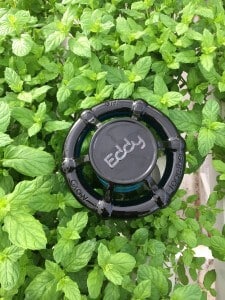A new Israeli development will help you grow fruits and vegetables at home without the need for experience or understanding in agriculture

By Maya Falah, Angle, Science and Environment News Agency
You probably won't be able to find many dietitians these days who will advise you to take the vegetables off your plate. From a health point of view, fresh vegetables should be an essential part of the diet of each and every one of us, and from an environmental point of view, it is now clear that fruits and vegetables are more environmentally friendly from the growth of animal food.
But it turns out that the industrial methods of growing fruits and vegetables are not without flaws: among other things, the fields and orchards occupy large areas, crowding out animals that lived in the area before it was used as an agricultural area. The agricultural areas also require intensive use of water resources, and minerals and fertilizers that penetrate the soil and pollute it. They are sprayed with many pesticides, which may damage the groundwater, marine ecosystems and even reach the plate. In addition, they also cause the emission of a large amount of greenhouse gases when transporting the food from the field to the consumer.
In fact, today over 37 percent of the land areas in the world covered in agricultural areas, most of them are dedicated to industrialized agriculture. Since the majority of the world's population currently lives in cities, and since the population is only growing and we all - what to do - need to eat, there is no escape from finding agricultural solutions that will allow us to continue eating without completely destroying the environment. From this concept grew the concept of sustainable agriculture: agriculture whose goal is to feed the world without consuming its resources, so that we can continue to exist and sustain ourselves in it over time.
One of the ways to do this is to grow the vegetables and fruits we eat ourselves, so that everyone can enjoy fresh, healthy and local produce. "But wait," you say, "we live in a one-meter-by-meter apartment in the city center," "I work hard and don't have time to invest in it," "even the pot next to my bed dies after a week." Or in short - who has the knowledge, the space and the time to bother with growing our own salad vegetables?
everyone can
B-Flux, an Israeli-American startup, think they know how to get us - who lack the time and experience - to do it too. In the company's research and development center located in Israel, the creators have developed a small robot called Eddy, which connects to an application of the same name on our smartphones, and allows even people with no experience in horticulture or agriculture - or without a deep understanding of soil chemistry or growing plants - to grow a garden Delicious homemade vegetables with a minimum of space, time and investment.
Edi is based on crops using the hydroponics method, a method of growing plants in water enriched with nutrients, without the need for soil. "There are millions of people in the world today who grow their crops hydroponically," says Karin Klosterman, founder of Flux and the company's marketing director. "This is a technique that is used by NASA to grow food for astronauts on space stations, and is very common among growers in Canada, who have helped to push and develop the method in recent years."
"It's much more soup to grow fruits and vegetables in a greenhouse," adds Klosterman, "with this method there are many things that can be done to improve the environment and the nutrition of the plant. The method basically makes it possible to control the micro-minerals and vitamins that the plant receives, the lighting around it, the acidity of its water, the ideal temperature for it, etc. And it turns out that it is also very efficient: it makes it possible to use 90 percent less water, save approximately the same amount of fertilizer used, and it also consumes significantly less space: a whole acre (about 4 dunams) of food can grow in a small shipping container. In addition, there is almost no need to use pesticides and no herbicides at all."
"Today there is a trend of growing interest in healthy nutrition. In China, for example, the soil today is so polluted that people are not interested in eating crops that come from there," says Klosterman. "Therefore, hydroponics - which does not require the use of soil - can be an excellent solution there at the moment. Beyond that, growing at home is a good solution for anyone for whom a healthy diet is important: when we buy vegetables at the supermarket, we don't know where they came from - usually not when we buy organic products either - we just trust that it will be fine. But when we create our own food, we take the power into our own hands: we know exactly where it comes from, and what ingredients went into it.'
What does my Gamba need?

Eddie - a lovable spherical robot based on artificial intelligence, the size of a large orange - is put into the water in the home hydroponic garden, where he analyzes the plant's environment and deduces the optimal conditions for it. That is, he checks whether there is a chemical balance in the system and whether the plant is currently receiving everything it needs to grow happily, or whether it needs some treatment. Accordingly, Eddy informs the amateur gardener at each stage what needs to be done by sending notifications to the smartphone: add water or nutrients, change the temperature or lighting in the room, etc.
"One of Eddy's goals is that we will be able to get exactly what we want from our plants," Klosterman explains. That is, if you are interested, for example, in getting a lot of vitamin C or sodium, the robot in the water will analyze the conditions in which the plant is found and suggest what to do to improve the conditions of each of these seedlings, without complicating you and explaining beyond what you want to know.'
Another thing you can do with the app is find out which of your neighbors also use it, and start swapping vegetables, get tips from other growers and maybe even start small local farmers' markets. "What was important in the vision of the product is the theme of community," adds Klosterman, "we wanted it to connect people. Let's create a network of breeders and farmers, who will talk and be able to help and give tips to each other, and maybe also be able to enjoy each other's products.'
Although the company does not offer a hydroponic system or seedlings, these can be easily obtained today: you can go to nurseries, gardening and household goods stores, or agricultural equipment, and choose a system according to the area you have in your house or balcony, and you can also make one at home simply and cheaply. You can purchase Edi for about 150 dollars starting in February 2017 by pre-order, and the company expects to start distributing the product about two months later, in April. From here, the road to the salad you grew yourself doesn't have to be particularly long and difficult.
